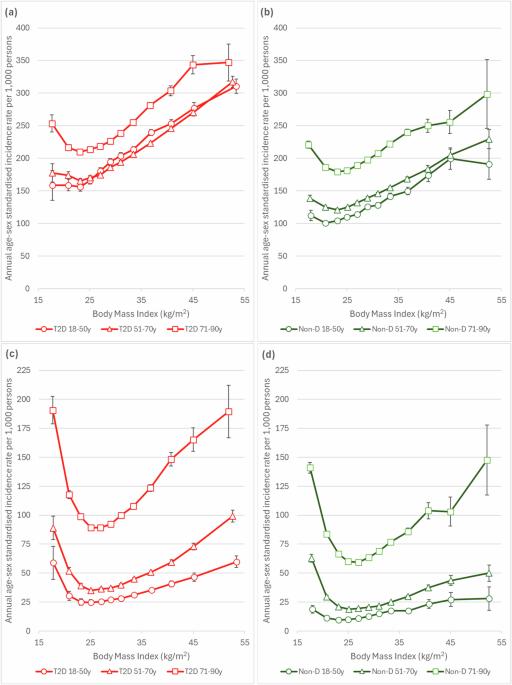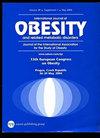2型糖尿病患者和非2型糖尿病患者的体重指数和感染风险:一项使用电子健康记录的队列研究
IF 3.8
2区 医学
Q1 ENDOCRINOLOGY & METABOLISM
引用次数: 0
摘要
背景:观察性研究发现身体质量指数(BMI)与感染之间呈u型关系。虽然2型糖尿病(T2D)患者通常更容易肥胖,感染的风险也更高,但目前尚不清楚BMI对糖尿病患者和非糖尿病患者的感染风险是否有相同的影响,以及这种影响是否因感染类型而异。方法:516,935例T2D患者和751,909例非糖尿病患者,年龄在18-90岁,于2015年1月1日存活,在临床实践研究数据链(Clinical Practice Research Datalink)中于2011-14年测量的BMI与年龄、性别和种族相匹配。从初级保健和相关的住院记录中整理了2015-19年期间的感染情况。泊松回归估计了感染的发病率比(IRR),跨越12个BMI类别(从≤19 kg/m2到>48 kgm2),使用参考组>24-≤26 kg/m2。使用单独的T2D和非糖尿病模型,调整年龄、性别、种族、贫困、吸烟和合并症。其他分析探讨了常见感染类型之间的关联。结果:在所有BMI水平下,t2dm患者的感染风险均高于非糖尿病患者,但在不同BMI水平下观察到的模式在两组中相似(例如BMI bbb48与BMI >24-≤26相比,t2dm IRR = 2.35, 95%CI 2.26-2.44,非糖尿病患者住院相关感染IRR = 2.52, 95%CI 2.30-2.75)。住院相关感染与BMI呈u型关系,不能用年龄、吸烟或合并症来解释,而初级保健感染主要与较高的BMI水平相关。蜂窝织炎表现出与高BMI水平相关的最强趋势,而下呼吸道感染和败血症与高和低BMI水平均相关。结论:t2dm患者的感染风险始终较高,但与BMI水平升高的关系在糖尿病患者和非糖尿病患者中似乎相似。此外,体重过轻也与需要住院治疗的感染风险增加有关。本文章由计算机程序翻译,如有差异,请以英文原文为准。

Body mass index and infection risks in people with and without type 2 diabetes: A cohort study using electronic health records
Observational studies have found U-shaped associations between body mass index (BMI) and infections. While people with type 2 diabetes (T2D) are generally more likely to live with obesity and be at higher risk of infections, it is unknown whether BMI has the same impact on infection risk in people with and without diabetes, and whether this varies by type of infection. 516,935 people with T2D and 751,909 people without diabetes, aged 18–90 and alive on 1/1/2015 with BMI measured during 2011–14 matched on age, sex and ethnicity in the Clinical Practice Research Datalink. Infections during 2015–19 were collated from primary care and linked hospitalisation records. Poisson regression estimated incidence rate ratios (IRR) for infection, across 12 BMI categories (from ≤19 kg/m2 to >48 kgm2) using a reference group of >24–≤26 kg/m2. Separate models for T2D and non-diabetes were used, adjusting for age, sex, ethnicity, deprivation, smoking and co-morbidity. Additional analyses explored associations by common infection types. People with T2D were at higher infection risk than people without diabetes at all BMI levels, however the pattern observed at different BMI levels was similar in both groups (e.g. BMI >48 compared to BMI >24–≤26, T2D IRR = 2.35, 95%CI 2.26–2.44, non-diabetes IRR = 2.52, 95%CI 2.30–2.75 for hospitalisation-related infections). Hospitalisation-related infections showed a U-shaped association with BMI not explained by age, smoking or co-morbidity, whereas primary care infections were predominately associated with higher BMI levels only. Cellulitis showed the strongest trends in relation to high BMI levels, whilst lower respiratory tract infection and sepsis were related to both high and low BMI levels. Infection risks are consistently higher for people with T2D but the association with increasing levels of BMI appears similar both in patients with and without diabetes. Additionally, being underweight is also associated with increased risk of infections requiring hospitalisation.
求助全文
通过发布文献求助,成功后即可免费获取论文全文。
去求助
来源期刊

International Journal of Obesity
医学-内分泌学与代谢
CiteScore
10.00
自引率
2.00%
发文量
221
审稿时长
3 months
期刊介绍:
The International Journal of Obesity is a multi-disciplinary forum for research describing basic, clinical and applied studies in biochemistry, physiology, genetics and nutrition, molecular, metabolic, psychological and epidemiological aspects of obesity and related disorders.
We publish a range of content types including original research articles, technical reports, reviews, correspondence and brief communications that elaborate on significant advances in the field and cover topical issues.
 求助内容:
求助内容: 应助结果提醒方式:
应助结果提醒方式:


